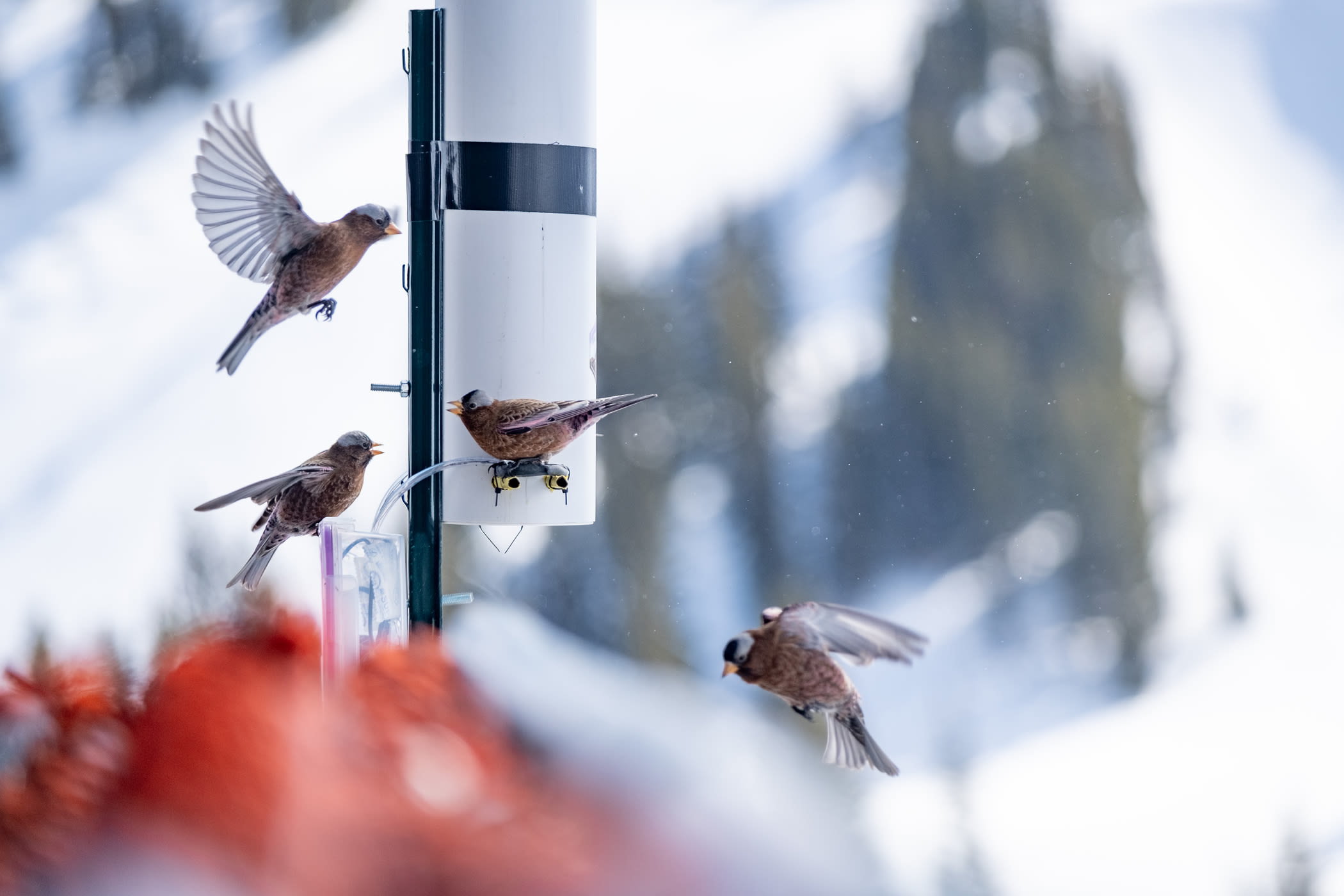ISSUE NO. 103
Download the Winter 2024 Newsletter
The Rosy-Finch Project

Four Gray-Crowned Rosy-finches at RFID feeder | Photo: Iz La Motte
Across Utah’s rugged mountain landscapes reside Black rosy-finches, Gray-crowned rosy-finches and Brown-capped rosy finches, The Black rosy-finch has historically been understudied. These finches are difficult to study because of their limited habitat distribution and the inaccessibility of their breeding habitat which is primarily located along high-altitude, alpine cliffs and crevices.
Alta Ski Area, with its lift-serviced access to 10,500 ft cliffs in rugged terrain, has become an important focal point location for studying these species of rosy-finches.
Black rosy-finch habitat is threatened as climate change is predicted to push alpine habitats upward in elevation. Without basic data on this species, conservation actions will be ill-informed or non-existent. In response to these critical data gaps, a collaborative study was initiated in 2020 led by led by Sageland Collaborative, U.S. Forest Service, Tracy Aviary, Utah State University, and Utah Division of Wildlife Resources, with support from the Alta Environmental Center (AEC).
The study employed an RFID (radio frequency identification) network of bird feeders that were placed throughout known finch migration habitats, leveraging technology and community scientists. In collaboration with trained scientists Gray-crowned and Black Rosy-finches are safely and temporarily captured and a small, RFID band is placed around their leg. Every time a banded finch visits one of the feeders, it pings its memory card with a unique identification of the bird, location, date, and time. These methods are key to filling in the vital data gaps regarding the species’ survival and distribution. The Alta Environmental Center has been assisting biologists working for the Division of Wildlife Resources in banding efforts at Alta Ski Area and in the Town of Alta. An RFID feeder is located at the top of the Collins lift and every two weeks, we retrieve the data from its memory card. Ski patrol, amid their demanding workload, assists with filling the feeder with black oil sunflower seeds. This shared responsibility not only fosters a common knowledge base but also demonstrates the power of collective action in conservation.
In its third year, the community-led rosy-finch feeder count portion of the study has concluded, but maintaining RFID feeders throughout Utah and continuously banding these Rosy-finches continues. The goal is to paint a clearer picture of the species’ status, enabling effective conservation actions. This collaborative endeavor not only contributes scientifically but also serves as a model for proactive conservation, illustrating how data-driven strategies can protect these mysterious mountain dwellers in the face of climate change.
To see this project in action check out the short film Sageland Collaborative produced on the rosy-finch project.
Nature Nugget – Ermine!

Ermine peaking out over the snow| Photo: Rocko Menzyk
In this Nature Nugget, we are spotlighting the Ermine! This elusive, small mammal plays a significant role in the delicate balance of our local ecosystems. Ermines (Mustela erminea), also known as short-tailed weasels or stoats, are captivating creatures that undergo a striking seasonal transformation. In warmer months, their fur is brown with a white belly, helping them camouflage into their surroundings. When winter descends and Alta’s landscape is blanketed in snow, the ermine undergoes a wardrobe change to a coat of pure white that blends in with Alta’s snowy slopes.
Ermines can be found across a variety of habitats from the Arctic tundra to temperate forests and meadows. They are often associated with terrestrial habitats such as forests, woodlands, and grasslands. This versatile creature is well-adapted to both lowland and alpine environments where fallen logs and rock crevices make great places for the ermine to take shelter and raise their young. These small mammals are also skilled diggers, where they can create burrows for shelter or utilize existing burrows of other animals.
One of the most remarkable features of ermines is their keen hunting ability. Despite their size, these carnivores are skilled predators. Their slender bodies allow them to navigate through dense vegetation, while their sharp teeth and claws make them efficient hunters of small mammals, birds, and insects. In the winter, their white fur aids in camouflage but also serves as insulation against the cold, enabling them to actively hunt in the snow-covered terrain.
These resilient creatures encapsulate nature’s remarkable ability to adapt and thrive in this high-alpine environment. From their seasonal style changes to their extraordinary hunting skills and boundless energy, these resilient mammals remind us of the wonders of our local flora and fauna.
NEW Snowshoe Event with Utah Cultural Site Stewardship & the State Preservation Office

Vintage photo of skiers on perch at Alta| Photo: Alan Engen Ski History Collection, Alta Historical Society
Join us for a journey through time in collaboration with the Utah State Preservation Office and Utah Cultural Site Stewardship Program. This inaugural snowshoe tour is not just a hike through the snow, it is an experience through a time capsule filled with tales that have sculpted Alta’s recreational history. Dive into how this picturesque landscape has evolved and adapted over the past century due to human influence.
Whether you are an outdoor enthusiast, a history buff, or simply love great company, this event ensures fun and inclusivity for all! Join us for this unique opportunity to celebrate the rich tapestry of the past, relish the beauty of the present, and envision the future of Alta. Discover your role as a steward of this land, contributing to the ongoing legacy of this remarkable landscape for the enjoyment of future generations.
- February 23rd, 2024
- 2-4pm
- Meet on East end of Albion grill
- Registration is Required

Add Your Comment